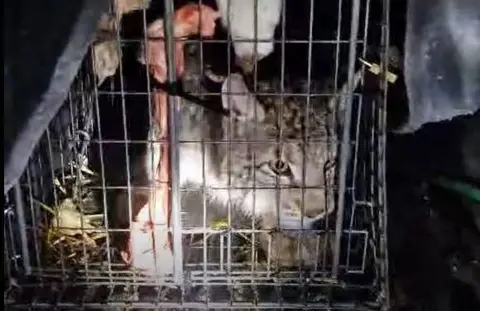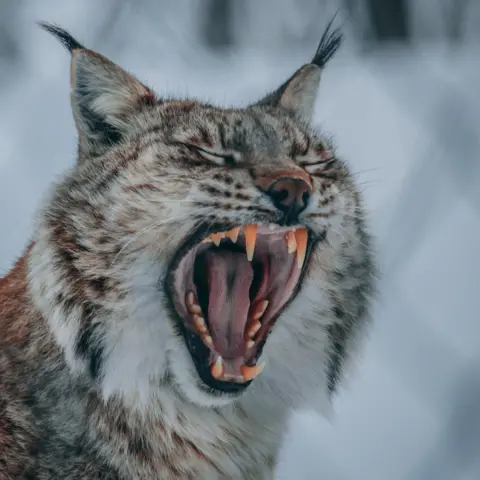Second pair of lynx captured in Cairngorms
A second pair of lynx have been captured after being found near Kingussie in the Cairngorms National Park.
Two other lynx, released illegally, were caught in the same area on Thursday.
Staff from the Royal Zoological Society of Scotland caught all the animals by baiting a series of humane traps in the area to entice them.
The RZSS confirmed that the latest pair had been captured at about 18:30 near the Dell of Killiehuntly, where the two other lynx were also successfully caught.
The latest lynx, believed to be larger than the other two cats, were first spotted at about 07:10 on Friday.
'In good health'
Dr Helen Senn, head of conservation at RZSS, said: "I'm sure that everyone in the community will be happy and relieved to know that the second pair of lynx have been safely captured.
"Early reports are that they appear to be in good health, which is the most important thing.
"It's been a rollercoaster 48 hours, with people working throughout the day and night, in some extremely challenging conditions, but I've been so impressed by the efforts of our own staff as well as partners, and members of the local community to ensure that the outcome is a positive one."
She added that the lynx would be taken to the Highland Wildlife Park before being moved to Edinburgh Zoo to quarantine for 30 days - as has happened with the first pair found on Thursday.
"Although we don't think that there are any more lynx out there, we will continue to monitor the release site under the direction of Police Scotland," she added.
RZSS has condemned the illegal release of wild animals.
David Field, chief executive of the RZSS, told the BBC News Channel he was "relieved" the animals had been captured.
He said their relationship with humans meant they were "looking for their food on a plate" and likely wanted to be rescued.
But Mr Field said it was "irresponsible and wrong" for people to attempt a "rogue rewilding".
He said: "These lynx were probably minimal risk, but there was a concern for the community because of the uncertainty.
"The reasoning behind people's abandonment of these animals, rogue rewilding or is it just the fact they were holding them as pets and they just abandoned them because they couldn't look after them?
"We don't know, and the origin of these animals we are still speculating on.
"Whatever it was, it was crazy, it was irresponsible and it should never, ever have been done."
 RZSS
RZSSPolice Scotland said inquiries were continuing to establish the full circumstances of how the four lynx came to be in the area.
A spokesman said: "We would continue to ask people not to travel to the area, particularly in the current weather conditions.
"Further inquiries will remain ongoing in the woods, involving officers and specialist animal experts."
The force earlier said inquiries suggested that both releases of lynx were connected.
The two animals trapped on Thursday have been confirmed as Eurasian lynx but their sex has still to be confirmed.
Some conservation groups have been campaigning to have the wild cats reintroduced to Scotland.
Those who support the idea include the Mammal Society, which has suggested rogue rewilders could be behind the releases.
The organisation said it would love to see a stable and healthy population of wild lynx thriving in the UK, and that the reintroduction of the species could "redress ecosystem imbalance and restore biodiversity to our depleted landscapes".
The society said it understood the "frustration" which could lead to illegal releases, but that there were "no shortcuts" to achieving its goal.
"Illegal releases are irresponsible and not the answer," it said.
What are lynx?
 Getty Images
Getty ImagesThere are four lynx species. Eurasian lynx are the largest.
Adults are roughly the size of a Labrador dog.
Lynx died out in Britain 500 to 1,000 years ago, but similar species are still found in continental Europe, Russia and Asia.
In the wild they prey on roe deer, young red deer and also hares and rabbits.
A licence is required under the Dangerous Animals Act to keep lynx.
Local authority Highland Council said no premises in the area had applied for, or were operating under a Dangerous Wild Animal (DWA) licence.
Are lynx dangerous?
The International Fund for Animal Welfare says lynx are mostly active at night and typically avoid humans.
It does warn that lynx, like other wild animals, could attack in self-defence if cornered.
WWF says attacks on livestock, such as sheep, are "much smaller than perceived".
Where were they seen?
 Getty Images
Getty ImagesIt is a landscape of hills, commercial forestry and native woodland on the edge of some of the highest mountains in the Cairngorms.
Insh Marshes, near Kingussie, is an RSPB Scotland reserve where beavers were recently released under licence.
Kingussie and the nearby village of Newtonmore are home to a total of about 1,500 people.
The area has seen heavy snowfall in recent days.
Cairngorms National Park is largest in the UK. It is twice the size of Lake District National Park.
Other animals once native to Scotland have been illegally released before.
They include wild boar and beavers.
